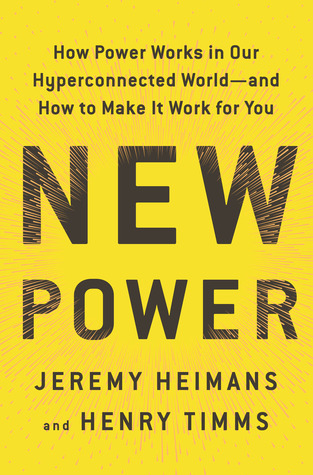More on this book
Community
Kindle Notes & Highlights
Read between
December 17, 2018 - November 20, 2019
The great challenge of the new power community is to weigh the needs of the three different groups, which can easily fall into conflict.
Moderators like Courtnie or Brian weren’t demanding money or credit,
but they wanted to be supplied with the tools to do their job better, and to be treated with respect by the administration.
The needs of platform owners, super-participants, and participants are often not aligned, and sometimes clash directly.
“platform culture,”
the analog of a corporate culture, but “without the directive authority or co-located social
systems that traditional firms can take advantage of to manage their employees.”
design choices.
Anyone wanting to understand the dynamics of a new power community—or design one for themselves—needs to wrestle with these key questions.
Who gets rewarded—and who “pays”?
Incentives and rewards in new power platforms shape whether—a...
This highlight has been truncated due to consecutive passage length restrictions.
participation...
This highlight has been truncated due to consecutive passage length restrictions.
It can be hard to find the right rewards to drive a new power community.
Sometimes a financial incentive gets the right result. Sometimes the sense of being part of something important will deliver more than cash. Often you need the right balance of both.
Whether money is in the mix or not, the critical task here is to create incentives that not only don’t treat participants like commodities, but also reinforce community norms.
Who gets recognized and who has status?
Recognition systems
that validate the work of participants or super-participants can be...
This highlight has been truncated due to consecutive passage length restrictions.
Well-designed, intangible reward systems can confer huge meaning for the individuals who take part in them.
The trick is to build status in a way that feels consistent with the ethos of the platform;
What creates stickiness?
At the heart of every successful new power platform is a great feedback loop.
We are all now hooked...
This highlight has been truncated due to consecutive passage length restrictions.
Done right, they can make people feel connected to one another and tied to something bigger than themselves.
These feedback loops can become more compelling when there is a time factor or collective goal in play.
Many new power networks simply wouldn’t function without the
reputation systems
that manage risk and incentivize collaborative beha...
This highlight has been truncated due to consecutive passage length restrictions.
Exactly how these systems are designed, however, shapes how effective they are.
Who calls the shots?
Many new power communities—especially corporate ones—can tend toward the other extreme, where the platform owners really call the shots, delegating only trivial choices to the masses.
This is a valuable study of how to engage and develop a super-participant.
Roadies were highly incentivized and bound together in tight-knit groups by a strong culture. Their job was to build a movement around each local moment, driving engagement, online buzz, and participation. They were invested in each small success, which added up to something bigger than each individual screening.
once Invisible Children moved outside the comfort of its triangle, it lost control of both the model and the message.
The super-participants, who had invested so much in the work of Invisible Children, were left feeling conflicted and disempowered.
Over the years, Uber had almost seemed to delight in picking fights with others in its circle.
In 2014, Travis Kalanick explained Uber’s worldview this way: “We’re in a political campaign, and the candidate is Uber and the opponent is an asshole named Taxi.”
Initially, Uber could rely on the support and energy of its drivers.
taxi drivers and Uber drivers began to recognize their common interests in the fight for better pay and conditions.
Uber’s move-fast-and-break-shit government relations strategy and its growing notoriety have also made it a hugely popular target for regulators.
In 2016 it was fighting more than seventy federal lawsuits in the United States, having settled another sixty. In London in 2017, Uber had its application to renew its operating license rejected.
Uber’s challenges are not just cultural, but structural.
In 2016, Uber lost $2.8 billion.
The next “buy local”–style movement could very well be “ride human.”
Ride Austin was created not simply as a replacement for Uber, but as an antidote to it.
It was an entrepreneurial attempt to create a ridesharing model that would be defined by community, not just by transactions.
What is behind Ride Austin isn’t a business at all, but a nonprofit. It is a ride-share service that serves the community, with a commitment to drive down costs and increase accessibility.
Ride Austin shares its ride statistics to help inform transit planning and help design better—and fairer—ways to move people around.
it presents a macro-challenge challenge for democratic discourse itself when Facebook, via its opaque algorithm, gets to choose who sees what and when.


